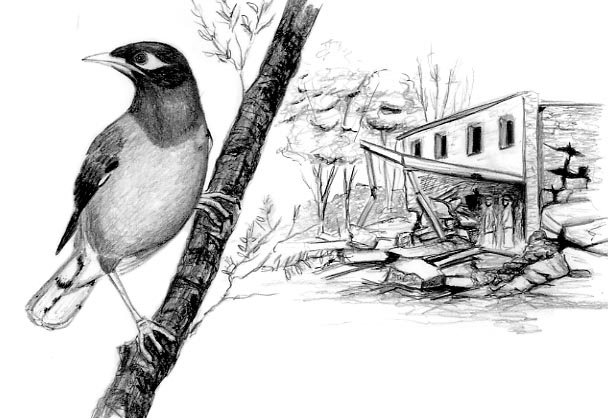
Dear Bird Folks,
I’m in the middle of my tour of duty in Kabul, Afghanistan. Every few weeks my Mom sends me newspaper clippings of “Ask the Bird Folks” from the newspaper. It’s a happy day when I receive them in the mail. There’s not a great variety of birds in this area; mostly pigeons, House Sparrows, European Starlings and Asian (Common) Mynas. I recall seeing these same mynas in Australia and South Africa. They were introduced to those areas to eat insects. My question is, were myna birds ever introduced into the United States for the same reason and if so what was the result?
-George, U.S. Army, Kabul, Afghanistan
Boy George,
Although I’ve never been to Kabul, things must be worse than I’ve imagined if receiving our column is the highlight of your week. Please don’t tell me that the Army has replaced Bob Hope with “Ask the Bird Folks.” Talk about cut backs. I sure hope they don’t expect me to go on one of those USO tours, because I can’t sing and my dancing has been banned in several states. However, if Ann-Margret is still on the tour and alive, count me in.
It’s understandable that you aren’t seeing a great variety of birds. As I recall, the Taliban didn’t have the best environmental record. And before those guys took over, the Soviets spent ten years trashing the place. As a result, the environment of Afghanistan looks like James Watt has been in charge. It’s definitely not been an easy stretch for the local birds. It seems a bit out of line to talk about birds in an area of the world that has seen so much destruction and suffering. But what is noteworthy, is that even in the worst conditions nature seems to find a way.
The birds that you have mentioned, George, are certainly the types of birds you would expect to find a way. House Sparrows, pigeons and starlings seem to thrive when other birds can’t take it anymore. The Common Myna is a full fledged member of the starling family and is able to adapt to many unusual conditions.
The Common Myna, when compared to the European Starling is a fairly attractive bird. It is 23 cm tall, (whatever that means), has a bright yellow beak, black head and a delicious looking chocolate brown body. When on the ground, the Myna has a bouncy, jaunty walk, moving around like a tiny Groucho Marx.
In its native homeland of South Asia, the myna is called the “FarmerÕs Friend” because of its habit of eating tons of crop destroying insects. It is a fearless bird and loves people, or at least it loves our buildings. Mynas will nest in holes of any manmade structure.
You were right when you said that you had seen mynas in Australia and South Africa. The title of “Farmers Friend” was appealing to the farmers around the world. In the mid 1800s mynas were transported to several countries and told to get to work chowing nasty insects. The mynas were happy to oblige, but in many areas they did their job too well. As often is the case, some countries found that they had merely replaced one pest with a more serious problem. In Australia the aggressive mynas have pushed out many of the little Aussie birds by taking over their nesting cavities. Over the years, the Australian myna population has soared and it is now one of their native birdÕs biggest threats, just behind habitat destruction and roving gangs of militant koalas.
You can bet mynas were introduced to the United States too. We didn’t want to be left out of the fun. They are very common birds on the islands of Hawaii, which are considered by many to be part of the United States. Fortunately, they seem to be getting along with the local Hawaiian birds. They spend the day eating army worms in the sugar cane fields and cause few problems, except for stealing the occasional roast pig from a luau. Southern Florida also has a small population of mynas. For a while biologists feared that they would spread and cause the same ecological problems that they have in Australia, but so far that has not been the case. As far as I know mynas have avoided other parts of the United States. They probably couldn’t stand listening to all those radio talk shows. Who can blame them?
It’s impressive, George, that with all that you having going on around you, you still are able to appreciate the birds. Good for you man. Also, I’m glad you are enjoying our columns. I’d be happy to deliver them to you in person, but first I have to work on my dancing and you have to get ahold of Ann-Margret.